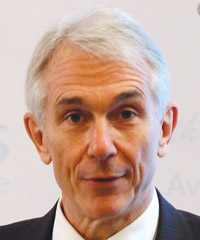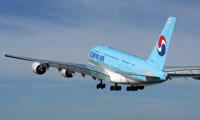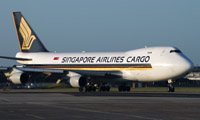Special Report: Security
A balancing act
While security rules for airline passengers remain a global patchwork of inconsistent regulations, on average, 12% of carriers’ revenue is earned from air freight. Speeding up the process of moving goods by air and ensuring they are transported safely and securely has become a major focus for operators.
June 1st 2013
When the director general of the International Air Transport Association (IATA), Tony Tyler, addressed AVSEC World, the annual gathering of aviation security professionals, in New York in March, he told delegates he was “greatly worried”. The cause of his concern: the possibility of security regimes – covering both passengers and freight – that attempted to completely eliminate risk from the process of air transport. Read More »
 |
| 'I believe the prevailing one-size-fits-all proscriptive model for security is not sustainable. If we don’t evolve, the system will grind to a halt under its own weight' |
| Tony Tyler Director General IATA |
“We cannot accept 100% risk. And any regulation that completely eliminated risk would shut the industry down — an equally unacceptable solution. A pragmatic approach is needed to balance the two. But I am not sure that we have achieved a common understanding with regulators on defining where that balance should be,” he said.
“Why? Because if we don’t find that balance soon we will lose the goodwill of our passengers and shippers, clog our airports, slow world trade, and bring down the level of security that we have worked so hard to build-up.
“Moreover, the challenge is growing. This year more than three billion passengers will travel by air — almost double the number that flew in 2001. And all forecasts point to another doubling by 2030, with air cargo growing at a similar pace.
“I believe the prevailing one-size-fits-all proscriptive model for security is not sustainable. If we don’t evolve, the system will grind to a halt under its own weight.”
A week later, at the World Cargo Symposium in Doha, Tyler elaborated his ideas, stressing that the entire freight supply chain played a critical role in security.
“It is more efficient and more effective to secure freight as it enters the supply chain than focusing all of our efforts at the airport where time and space are limited,” he told delegates.
And he disclosed that the IATA-developed Secure Freight, a ready-made template for states to use, is paying off.
“It has been successfully trialled in eight countries. The first pilot scheme in Malaysia proved that it is an effective way to manage cargo security,” said Tyler.
“And analysis of the trial provided the basic data to estimate that implementing Secure Freight principles in Malaysia would result in a $1-$2 billion boost to its economy over five years.”
Secure Freight, which has been introduced permanently in Malaysia, is aimed at providing guidance on cargo security, based on understanding the identity of the shipper and other members of the supply chain. It ensures cargo is secured upstream and maintained in sterile conditions along the way.
Among the countries scheduled to follow Malaysia are Kenya, Mexico, Chile and the United Arab Emirates (UAE).
But in contrast with this success, the road towards what airlines want in terms of an acceptable security regime is proving painfully slow.
 |
| 'In the face of further attempts by the U.S. and other governments to impose unilateral new cargo security measures, the AAPA calls on governments to recognize the benefits of adherence to common global standards established by ICAO' |
| Andrew Herdman Director General AAPA |
The IATA chief was reflecting the concerns of the entire aviation and freight handling industry, in that the debate is not just about security alone, but how the entire freight system operated.
Airlines want security, but they want globally accepted rules and agreement between states to accept each other’s security protocols. Just as importantly they want the system to be increasingly efficient.
As the director general of the Association of Asia Pacific Airlines (AAPA), Andrew Herdman, put it during the group’s Assembly of Presidents late last year, the robustness of the international freight industry depends on a web of trusted relationships among the many stakeholders.
“In the face of further attempts by the U.S. and other governments to impose unilateral new cargo security measures, the AAPA calls on governments to recognize the benefits of adherence to common global standards established by ICAO, thereby responding more effectively to the needs of the air cargo supply chain,” he said.
Herdman’s view echoes the fears of many industry insiders that there is a recurrent theme in the drive towards an acceptable security regime: since the 9/11 terrorist attacks in New York action on the security front has involved the rest of the world reacting to Washington.
For example, the U.S. Transportation Security Administration (TSA) deadline for screening all cargo on U.S.-bound passenger planes came into effect last December, although the rule-making process to cement it into U.S. law is not expected to be completed until later this year.
There have been serious reservations about how this would impact cargo movements in terms of delays, but in its first six months there have not been any of the expected problems. There have been no complaints from airlines or freight forwarders.
Some airlines were prepared. For example, Korea’s government had enforced 100% X-ray screening for all cargo on passenger planes departing from the country.
Korean Air, one the world’s largest freight operators, pointed out it faced extra costs and less efficiency in terms of operational service from additional screening activities for transit cargo specifically going to the U.S.
Ongoing calls for ICAO to take the lead in pushing towards a harmonized system has been a common theme.
The Global Air Cargo Advisory Group (GACAG), in its latest position paper on the issue, said ICAO should serve as the focal point for implementing global air cargo supply chain security standards.
It said it “supports global standards and programmes with regulatory backing around the world” and “calls for ICAO, in collaboration with other international organizations, to take the lead role to continue improvements in the security of the global air cargo supply chain.”
 |
| Korean Air: faced extra costs from additional screening activities for transit cargo going to the U.S. |
Said GACAG chairman, Michael Steen: “GACAG welcomes mutual recognition as a way for regulators to facilitate the movement of cargo along the air cargo secure supply chain without requiring redundant security measures, specifically at transit/transfer points.”
The executive director of the Airforwarders Association (AfA), based in Washington, Brandon Fried, agreed: “We believe that the key to successful air cargo security lies in the harmonization of international supply chain regulations and standards … leveraging the collaborative mission of ICAO allows all nations to participate in developing a globally acceptable set of standards, guidance and templates that reduce confusion while supporting industry best practices.”
But ICAO has been active. Its officials have been touting stricter airfreight security requirements since the thwarted 2010 Yemen cargo bomb plot. In 2011, it signed a Memorandum of Understanding with the World Customs Organization to protect airfreight from acts of terrorism or other criminal activity, as well as accelerate the movement of goods by air.
It unveiled its more stringent cargo security measures last year, one of which requires member states to establish supply chain security processes.
Also last year, a landmark agreement between the U.S., the European Union (EU) and Switzerland was reached for mutual recognition of cargo security regimes. It had taken seven years of effort by regulators and industry stakeholders to come to fruition.
The IATA cargo committee agreed to adopt the e-Consignment Security Declaration (e-CSD) wherever it has been adopted by regulatory authorities. They also supported e-CSD pilot programmes in Singapore, Canada and South Africa.
IATA’s vision is for a risk-based, multi-layered secure supply chain approach which will be bolstered by electronic data sent well in advance of flights and underpinned by improvements in technology.
 |
| Singapore Airlines Cargo: among airlines pursuing policies that will lead to 100% e-AWB from their hubs by the end of the year |
A key part of the path towards “efficient security” are efforts to reach 100% use of electronic waybills (the e-Air Waybill or e-AWB) by the end of 2015. This is part of a renewed commitment to improve air cargo competitiveness across the supply chain, including industry consensus on moving e-freight forward and on pursuing a risk-based approach to supply chain security.
A major milestone was reached on e-freight with the approval by the Cargo Services Conference of the Multilateral e-AWB at the gathering in Doha. This will remove the need for individual bilateral e-AWB agreements between airlines and freight forwarders and will be a major boost to e-AWB penetration.
“The most important thing that we can do to improve the competitiveness of the air cargo industry is e-freight. It is a top focus for the Global Air Cargo Advisory Group (GACAG) which produced a roadmap to coordinate industry efforts,” said Des Vertannes, IATA’s Global Head of Cargo.
IATA’s board of governors has set ambitious targets. “At the end of 2012 e-AWB penetration was 6.8%. By the end of 2013 the target is 20%. And the big challenge is to reach 100% by the end of 2015. The approval of the Multilateral e-AWB is the most important new cargo standard developed in the last two decades. It gives us critical momentum to achieving the e-freight vision,” said Vertannes.
Asia-Pacific airlines are playing a leading role. Cathay Pacific Airways, Singapore Airlines Cargo and Korean Air (along with Emirates Airline) are pursuing policies that will lead to 100% e-AWB from their hubs by the end of this year, well ahead of the target. As a result of that commitment, the carriers were responsible for some 77% of e-AWBs issued in 2012.
Tyler said airlines remain focused on a supply chain approach to screening that takes full advantage of the capabilities of all stakeholders.
“We are being guided by many of the same principles as our work on passenger security. This means using global standards, risk-based analysis and working together, rather than a top-down, rules-driven, state-by-state approach,” he said.
“Mandates that are not aligned with the way the air cargo business operates will be impossible to implement effectively without eliminating the rationale for the business, which is speed of delivery.”
Tyler said the U.S. Air Cargo Advance Screening (ACAS) programme is at the leading edge of the business. “The U.S. Customs and Border Protection (CBP) and TSA launched this programme in close cooperation with the airlines, freight forwarders, Airlines for America, IATA and other industry stakeholders. Under ACAS, CBP identifies a set of cargo data to be transmitted by the airline within given timelines,” he said.
“This is a significant step forward and could lay the foundation of future cargo security. But I am concerned that political pressure is being exerted to write laws before the testing phase is complete.
“We must do this right and not rush the rulemaking process. And when finalized, ACAS capabilities must be fully utilized in TSA air cargo rules, CBP inspection requirements and with international trading partners.”
Tyler’s message is clear. “The greatest benefit of security initiatives will be derived when states mutually recognize their security regimes … and we must recognize that 99.99%, if not more, of passengers and freight pose no threat to aviation. So we need to make better use of the information that is available to assess the risk of the people, objects or situations that can pose threats.
“These principles would lead to security that is driven by the desired outcomes not the processes, which is pragmatic, not bureaucratic and that is efficiently focused on mitigating risks rather than on mechanically repeating procedures ad infinitum.”